

LOT 4a
Monumental 17th C. Italian Painting - Lamentation
European, Italian, 17th century. Initials at bottom center - possibly “GB”, “JR”, or “JF”.
Size (with frame): 77.5” L x 101.5” W (196.8 cm x 257.8 cm)

A monumental oil on canvas painting depicting the Lamentation Over the Deposed Christ. There has been some speculation that this painting was created by Giovanni Battista Beinaschi (Fossano 1636 - 1688 Naples) who trained in Rome but was active in Naples during the second half of the 17th century. Others have speculated that this painting was created by the School of Jusepe de Ribera or the Neapolitan School of Italian Art. The composition presents the body of Jesus Christ deposed from the Cross with the Virgin Mary, St. John the Evangelist, three pious women - perhaps the Three Marys (Mary Magdalene, Mary of Clopas, and Mary Salome) - and two angels sharing in their grief. A striking Old Master painting of considerable size rendered with fine modeling, rich hues, and brilliant tenebroso (dramatic lights and darks) and mounted in a custom wood frame. An exceptional piece that is worthy of conservation work and would stand out in any fine art collection.
LOT 22
Exhibited Esterio Segua Mixed Media “Los Dragones” 1996

LOT 5
18th C. Follower of Guido Reni“Fortuna with a Purse”
18th C. European Follower of Guido Reni (Italian, 1575-1642), after “Fortuna with a Purse” (1636 to 1637).
Size: 55” L x 49” W (139.7 cm x 124.5 cm)
A monumental oil on canvas painting depicting Fortuna, the Roman Goddess of Fortune, holding a palm and sceptre in her left hand and a purse in her raised right hand, as coins and pearls drop toward the globe below.
Esterio Segura (Cuban, b. 1970). “Los Dragones del Castillo Me Comieron las Partes Mas Sensibles” mixed media: watercolor, India ink, and graphite on paper, 1996.
Size (artwork): 48” L x 33” W (121.9 cm x 83.8 cm) Size (frame): 52” L x 37” W (132.1 cm x 94 cm)
A striking mixed media composition by Cuban artist Esterio Segura featuring five dragons with crocodile bodies feasting upon the “sensitive” body parts of a nude male with blood dripping from the open wound located over his heart.
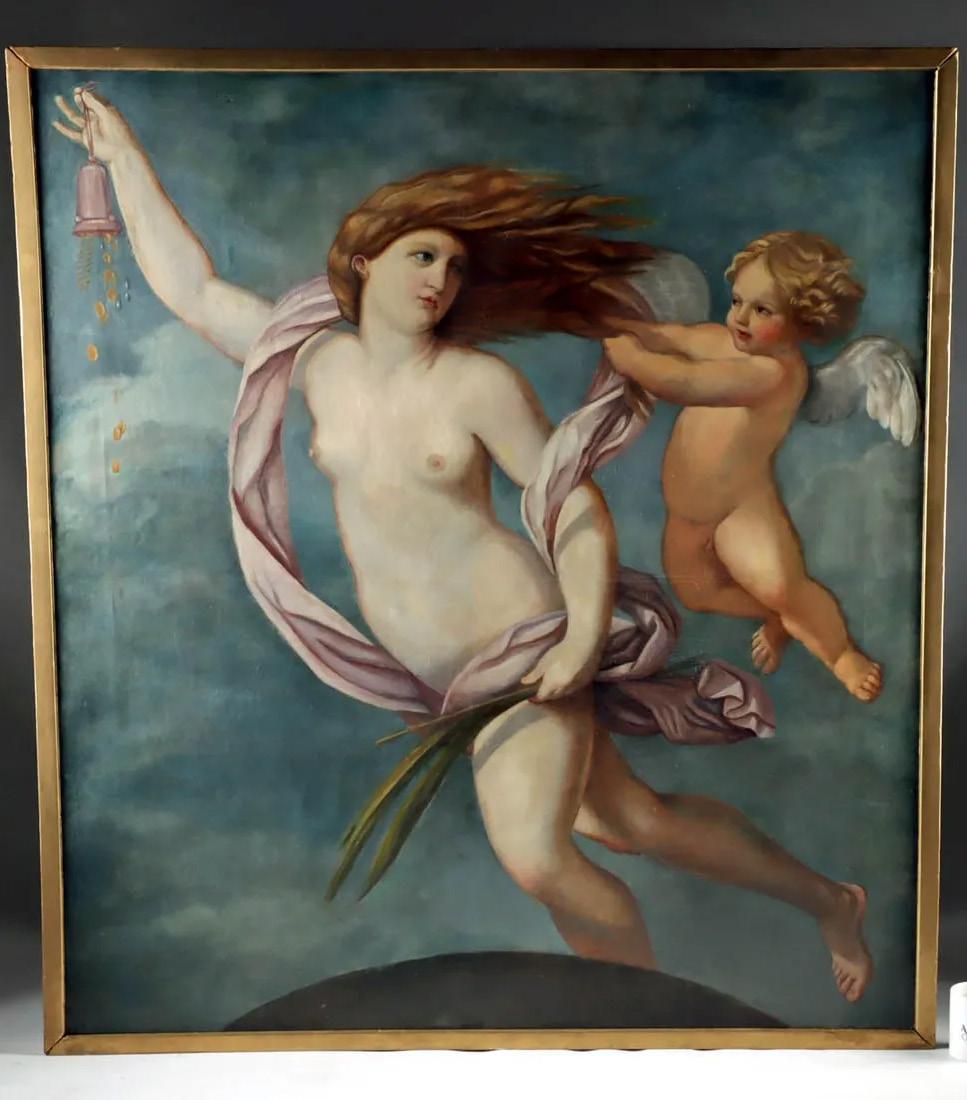

LOT 3 Bronze “Chat Maitre d’Hotel” after Diego Giacometti
Cast patinated bronze, 1967-1981. Signed “Diego G” lower right on base.
Size: 11.875” H x 9” L x 3.25” W (30.2 cm x 22.9 cm x 8.3 cm)
A wonderfully whimsical standing bronze cat holding a serving tray titled “Chat Maitre-d’Hotel” by Diego Giacometti, who adored animal forms.
LOT 19
William Tolliver Charcoal on Board - Nude (1990s)

Nude study, charcoal on plywood, ca. 1991 to 1992. Signed at lower left.
Size: 32.25” L x 44” W (81.9 cm x 111.8 cm)
A rare charcoal study by self-taught African-American artist William Tolliver depicting a female nude in a classic reclining pose akin to a Renaissance Venus.
LOT 19a
Alena Vavilina - Butterflies #36 w/ Silver & Gold Leaf
Gold leaf, silver leaf, and ink on paper, 2023. Signed “AV” in lower center
Size: 25.59” W x 39.76” H (65 cm x 101 cm)
A dazzling composition by award winning contemporary artist Alena Vavilina from Vavilina’s Butterflies Series. Nature is Vavilina’s greatest muse, and this piece features dozens of butterflies delineated in fuchsia and teal against a brilliant gold leaf ground - a dramatic presentation created via a painstaking process.

LOT 32
Signed Rene Lalique “Sauterelles” Art Glass
Vase (1912)

Number 888. Signed (acid etched) “LALIQUE” on underside near edge of base.
Size: 10.25” Diameter x 10.875” H (26 cm x 27.6 cm)
A delightful clear glass “Sauterelles” vase with blue staining designed in 1912 by the great Rene Lalique, a French master jeweler who was famous for his luxury glassware of the Art Nouveau and Art Deco movements. The botanical composition displays a whimsical design of grasshoppers resting on long reeds of grass that arch across one another in a natural lattice pattern. The vessel highlights the master’s love of the bold forms and natural motifs that typified his output. Mold-formed from clear glass with blue staining, this vase embodies the elegance and artistry of Lalique’s most beloved designs.
LOT 39
Tall Egyptian Predynastic Naqada Black Top Jar
Ancient Egypt, Predynastic period, late Naqada I to early Naqada II, ca. 3600 to 3300 BCE.
Size: 7” Diameter x 9.7” H (17.8 cm x 24.6 cm)
A beautiful Nile silt pottery jar of tall, ovoid form that was constructed with a coil-and-scrape technique and decorated with layers of iron-oxide slip. The upper blackhued portion is comprised of thick carbon deposits formed by thick clouds of smoke for extended periods of time in an oxygen-deprived environment.


LOT 40a
Lifesize+ Egyptian Painted / Gesso Wood Mummy Mask
Ancient Egypt, Late Dynastic Period, 26th to 31st Dynasty, ca. 664 to 332 BCE.
Size: 5” L x 10.375” W x 12.25” H (12.7 cm x 26.4 cm x 31.1 cm); 16.25” H (41.3 cm) on included custom stand.
A hand-carved wooden mummy mask covered in a layer of white gesso and painted with vibrant pigments. The almondshaped eyes exhibit elongated outer canthi, sweeping brows, tall ears, and a slender nose, all above a pair of red-painted lips and a protruding chin, the base of which likely once bore a false beard.
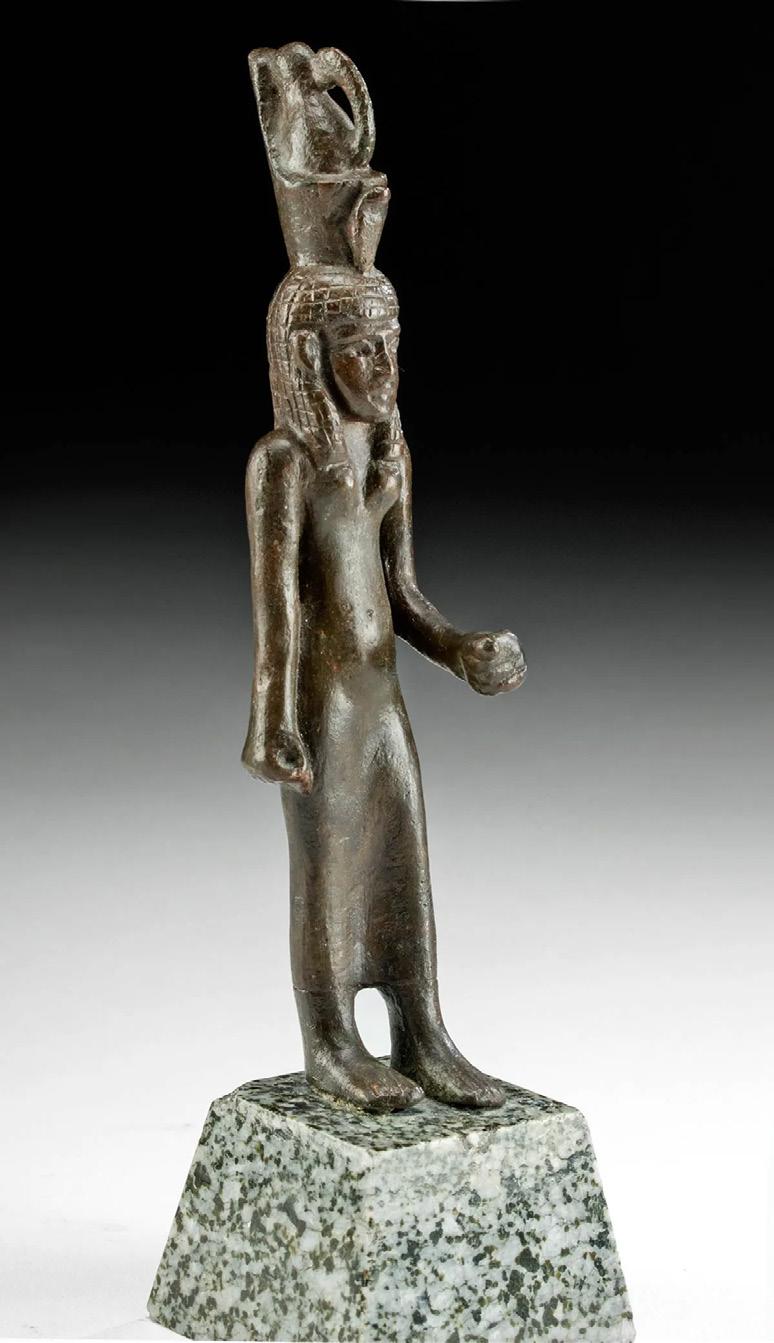
LOT 42
Museum-Exhibited Egyptian Bronze Figure Goddess Mut
Ancient Egypt, Third Intermediate to Late Dynastic Period, 25th to 26th Dynasty, ca. 744 to 525 BCE.
Size: 1.125” W x 5.125” H (2.9 cm x 13 cm); 6.3” H (16 cm) on included custom stand.
An exceptionally well-preserved figure of the goddess Mut, cast from leaded-bronze, presenting striding with her left foot barely extended beneath a bent left arm which held a scepter at one time. Her elegant femininity is accentuated by her form-fitting sheath dress, her navel daintily impressed in the center of her abdomen, while perky breasts protrude just beneath her shoulders.
LOT 42b
Early Cycladic II Marble Head, Spedos Variety
Ancient Greece, Early Cyclades II, Early Spedos type, ca. 2600 to 2500 BCE.
Size: 4.53” H (11.5 cm)
A finely-carved marble head of a Spedos-type figure. The low relief triangular nose is slightly pronounced above a smooth mouth area and a rounded chin, with chips around the neckline indicative of once belonging to a much larger figure.

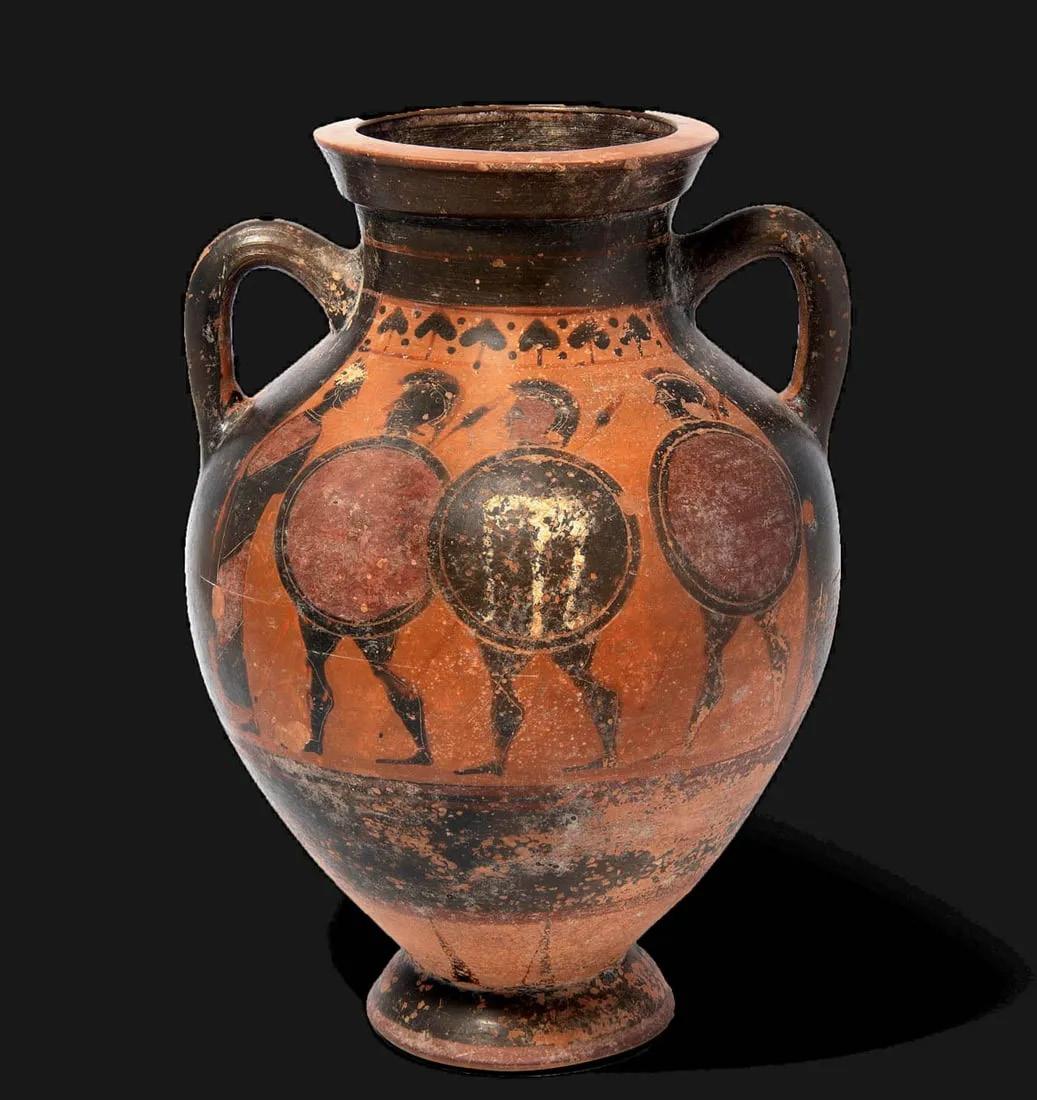
Attic Black-Figure Amphora, Warrior Farewell Scene
Greece, Athens (Attic), ca. 580 to 550 BCE.
Size: 9.5” Diameter x 13.5” H (24.1 cm x 34.3 cm)
An opulent black-figure amphora featuring an ovoid body, a flared rim, and vertical, arched handles, all sitting upon an annular foot. The exterior is adorned with 2 figural scenes, each beneath a frieze of ivy leaves. The first scene shows a Warrior Farewell scene with a center female figure accompanied by 2 attendants as she addresses a nude youth with a robed man standing behind him. Alternatively, the other side depicts 3 warriors, each equipped with a helmet, shield, and lance as they stride left to confront a bearded man.
LOT 53
Fine Roman Marble
Portrait Herm of Apollo
Roman, Imperial period, ca. 1st to 2nd century CE.
Size: 3.2” L x 4.75” W x 7.3” H (8.1 cm x 12.1 cm x 18.5 cm)
A wonderful marble portrait herm of Apollo with his hair arranged in 3 rows of coils at the top of his head, while long wavy tresses fall down to his shoulders, faming his idyllic visage.

LOT 43c
Translated Greek Marble Stele - Farewell Scene
Hellenistic period, ca. 4th to 3rd century BCE.
Size: 4.5” L x 19.5” W x 32.5” H (11.4 cm x 49.5 cm x 82.6 cm)
A stunning marble stele depicting a farewell scene between a soldier and a male and female figure, accompanied by 3 lines of Ancient Greek text below likely dedicating the piece. Standing beside his horse, the helmeted warrior wears a tunic and cape and holds a spear while shaking the hand of the robed male.

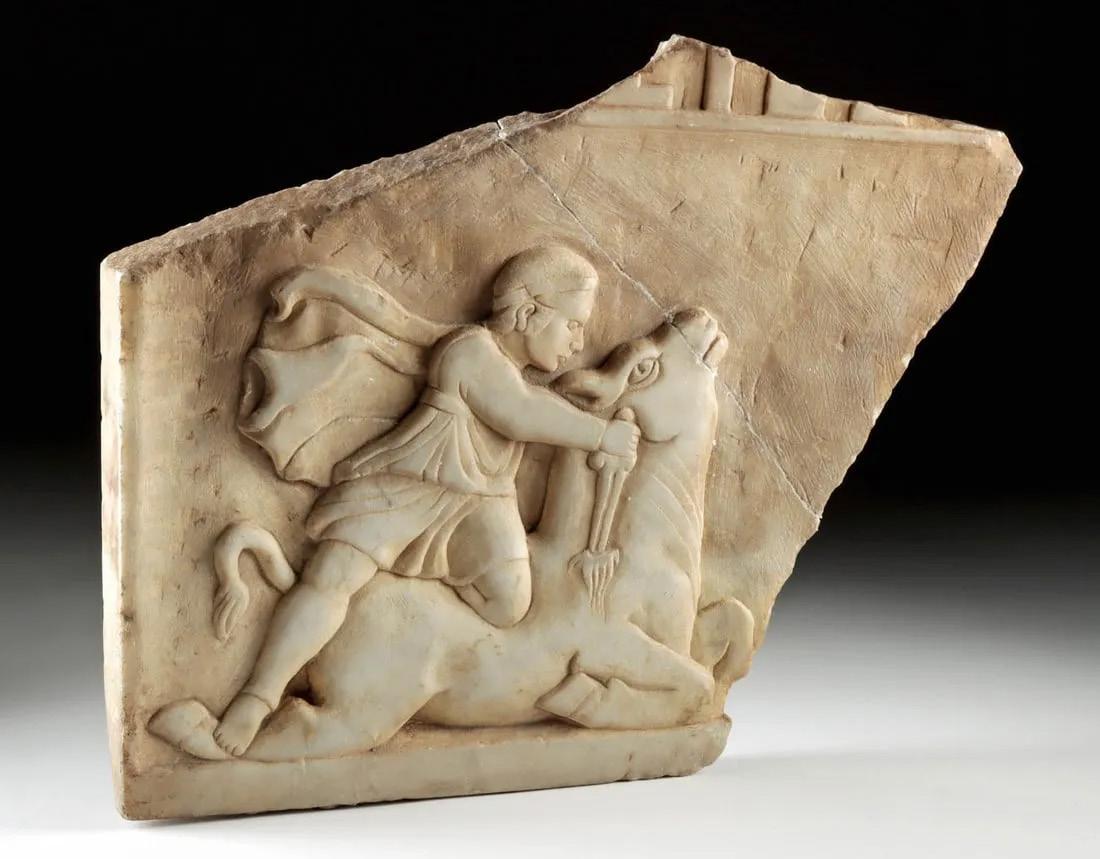
Roman, Imperial period, ca. 3rd century CE. Size: 1.2” L x 15.4” W x 12.1” H (3 cm x 39.1 cm x 30.7 cm)
An enticing marble relief depicting Mithras killing a sacred bull (tauroctony) - the iconic act of Mithras commemorated in the Mithraeum where Roman soldiers were assigned.
LOT 47
Roman Marble Relief Mithras Killing Bull (Tauroctony)

Lot 59
Roman Bronze Cautes / Cautopates Figure, ex-Sotheby’s
Roman, Imperial period, ca. 1st to 2nd century CE.
Size: 1.6” L x 3.3” W x 6.8” H (4.1 cm x 8.4 cm x 17.3 cm); 8.3” H (21.1 cm) on included custom stand.
A rare and quite remarkable bronze figure of a cautes or cautopates, an attendant of the sun god Mithras, depicted traditionally in a Phrygian cap and Persian style garments that emphasize the supposed oriental origins of the Mithraic cult.
lot 59b 3rd C. Early Medieval
European Iron Helmet w/ Ear Flaps
Northern Europe, early Medieval period, possibly Germanic or Anglo-Saxon, ca. 3rd to 7th century CE.
Size: 9.4” L x 8.5” W x 14.5” H (23.9 cm x 21.6 cm x 36.8 cm); 22.25” H (56.5 cm) on included custom stand.
An exceptional iron helmet dating to the period of mass confusion and European turmoil after the fall of the Roman Empire. Battle helmet showing strong Roman influence, but clearly elements of other helmet styles found in western Europe at this time.
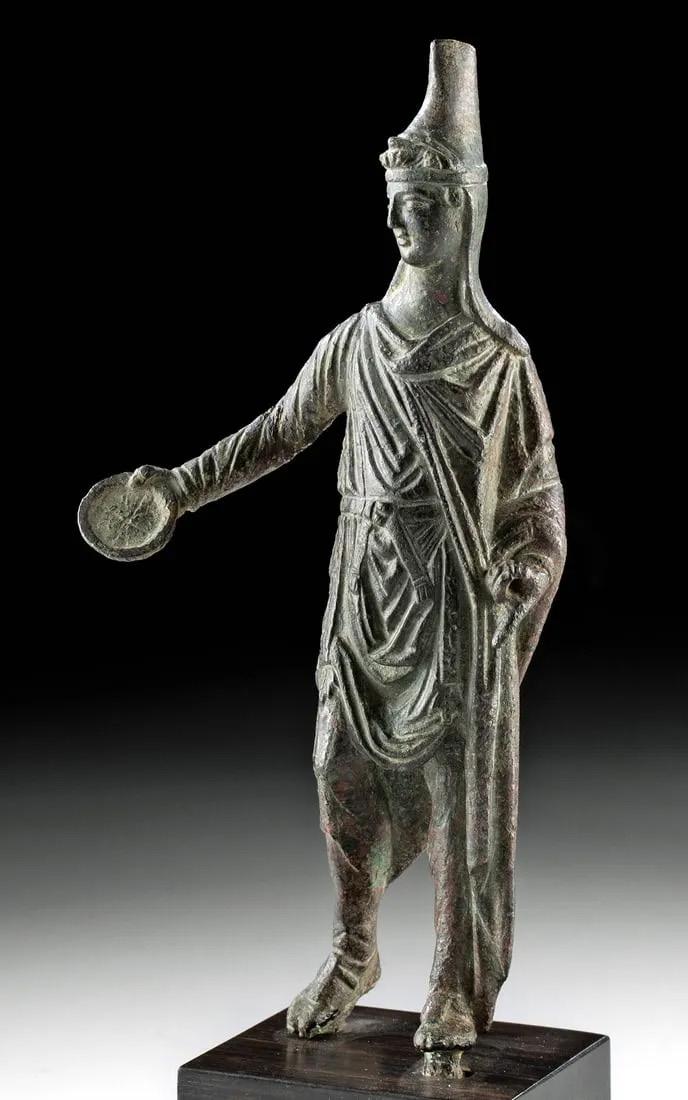
lot 59a
Neolithic Marble Steatopygous Idol (Voluptuous Female)
Southeastern Europe, Balkans / Mediterranean Region, late Neolithic / Early Bronze Age, ca. 5000 to 3000 BCE.
Size: 4.5” H (11.4 cm)
An important Neolithic marble voluptuous female figure known as a “steatopygous” idol, due to the “tissue” on the thighs and buttocks. This idol has considerable tactile appeal and was most likely designed to be handled.


lot 42c
Rare Greek Silver Taras Stater (in 22K+ Gold Fairchild Pendant)
United States, New Mexico, Santa Fe, ca. late 20th to 21st century CE.
Size of pendant: 1.65” L x 1.22” W (4.2 cm x 3.1 cm); coin: 0.87” Diameter (2.2 cm); gold quality: 92.79% (equivalent to 22K+); silver quality: 96.56%; weight: 23.8 grams
A gorgeous and wearable Fairchild & Co. gold pendant with an ancient silver Greek coin at the center. The coin is a rare silver Taras stater, circa 280 to 272 BCE, the reverse facing forward with Taros / Phalanthos riding a dolphin right, holding a bow in one hand and arrow in the other, and an elephant below.
lot 48
Roman Chalcedony Intaglio
Romulus & Remus (in Gold Ring)
Roman, Imperial period, ca. 1st to 2nd century CE; Europe, ca. 19th century CE.
Size of ring: 0.875” L (2.2 cm); of intaglio: 0.4” L x 0.375” W (1 cm x 1 cm): US ring size: 6.25; gold quality: 75.1% (equivalent to over 18 karats); weight: 2.3 grams
A gorgeous blue chalcedony intaglio from Imperial Rome, depicting the mythological twins of Romulus and Remus being nursed by a she-wolf surrounded by wreath border, all set in a 19th-century gold ring to be wearable.

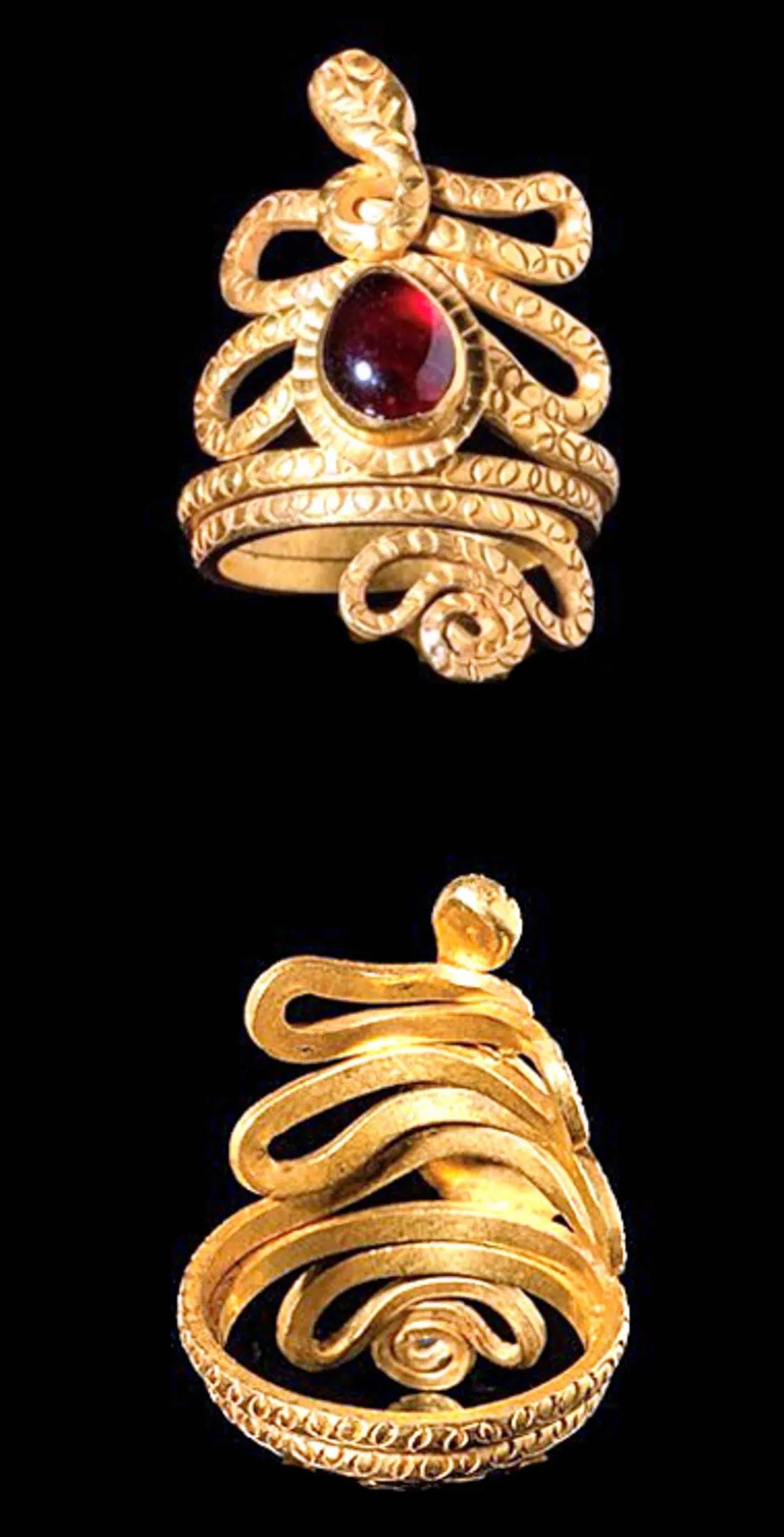
lot 50b
Superb Roman 21K+ Gold Ring, Coiled Snake w/ Garnet
Roman, Republic to Imperial period, ca. 100 BCE to 100 CE.
Size of band: 0.72” Diameter (1.8 cm); US ring size: 8.5; gold quality: 88% to 89.5% (equivalent to 21K+); weight: 12.2 grams
A spectacular 21K+ gold snake ring inlaid with a garnet cabochon, the surface embellished with stamped markings for scales.
LOT 58
Roman Carnelian Intaglio Maenads & Altar (in
Gold Swivel Ring)
Roman, Imperial period, ca. 1st to 2nd century CE; Europe, ca. 19th to early 20th century CE.
Size: 1” L x 0.8” W (2.5 cm x 2 cm); of intaglio: 0.375” diameter (1 cm); US ring size: 8; gold quality: 75.7% (equivalent to over 18 karats); weight: 2.9 grams
A beautiful carnelian intaglio from ancient Rome depicting the incised image of 2 female figures - likely Bacchantes (Greek Maenads) - at the altar of Bacchus (Greek Dionysus), the Roman god of wine, all set in a 19th to 20th-century gold swivel ring.

LOT 59d
Stunning Viking 23K+ Gold Twisted Ring
Northern Europe, Scandinavia, Viking or Norse culture, ca. 8th to 10th century CE.
Size: 0.19” L x 1.05” W x 1.05” H (0.5 cm x 2.7 cm x 2.7 cm); gold quality: 98.4% (equivalent to 23K+); weight: 9.3 grams; US ring size: 9.75
A beautiful and wearable ring of twisted form shaped from lengths of 98.4% gold (equivalent to 23K+). Between each of the thicker bands along the upper half of the shank are thinner bands of tightly-coiled gold, and the spiraling form smooths out to form the solid shank along the bottom portion.

LOT 60a
Stunning Gandharan Schist Buddha - Twin Miracles
Central Asia, Pakistan, Afghanistan, Northern India, Gandhara / Kushan Empire, ca. 2nd to 3rd century CE.
Size: 8” W x 24” H (20.3 cm x 61 cm)
A superb schist stone carving of a standing Buddha performing Twin Miracles. The figure stands upright, radiating an aura of serenity and spiritual power. The figure’s head with carefully arranged hair is backed by a halo with the flames miraculously emerging from his shoulders and water from his feet. Carved with naturalistic features, his visage presents deep-cast, almondshaped eyes, a broad nose, arched eyebrows, gently smiling lips, round cheeks, chin, and elongated earlobes.

LOT 60B
Important Ancient Bactrian Chlorite Idol - Seated Female
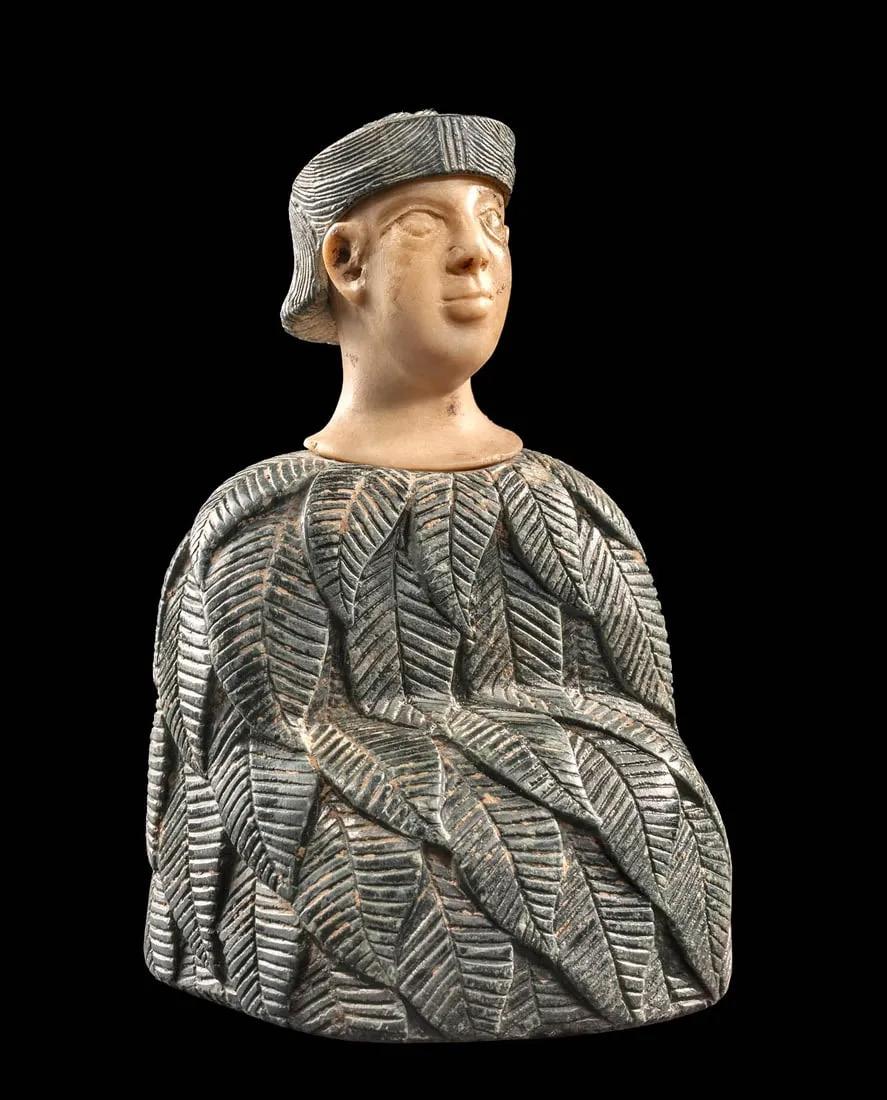
Ancient Central Asia, Bactria, ca. 3rd millennium BCE.
Size: 2.5” L x 3” W x 5” H (6.4 cm x 7.6 cm x 12.7 cm)
A highly important Bactrian chlorite and polished limestone female figure in a dignified seated position. The figure is adorned with a leafy garment beautifully rendered forming a necklace like collar.
Opulent Chinese Tang Dynasty Gilt Openwork Crown Phoenixes

LOT 65
Chinese Ming Dynasty
Seated Mahasthamaprapta
East Asia, China, Ming Dynasty, ca. 15th to 16th century CE.
Size: 9.5” L x 15” W x 23” H (24.1 cm x 38.1 cm x 58.4 cm)
A beautiful brass figure of Mahasthamaprapta, the bodhisattva mahasattva who represents the power of wisdom, seated in dhyanasana with left hand in vitakamudra and right in dhyanamudra.
East Asia, China, Tang Dynasty, ca. 618 to 906 CE.
Size: 8” L x 12.2” W x 10.3” H (20.3 cm x 31 cm x 26.2 cm); 20.5” H (52.1 cm) on included custom stand; of custom display case: 14.5” L x 20.5” W x 20.75” H (36.8 cm x 52.1 cm x 52.7 cm)
An opulent and quite rare gilt brass crown boasting elaborate openwork imagery of phoenixes amongst scrolling wisps of clouds and flame-like motifs.

LOT 67
12th C. Khmer Sandstone
Antefix w/ 5-Headed Serpent
Southeast Asia, Cambodia, Khmer Empire, ca. 12th century CE.
Size: 13.2” L x 25.9” W x 35.7” H (33.5 cm x 65.8 cm x 90.7 cm); 42.5” H (108 cm) on included custom stand.
A magnificent, hand-carved stone antefix in the form of a 5-headed serpent or naga with the central head holding a garland of jewels in its mouth.
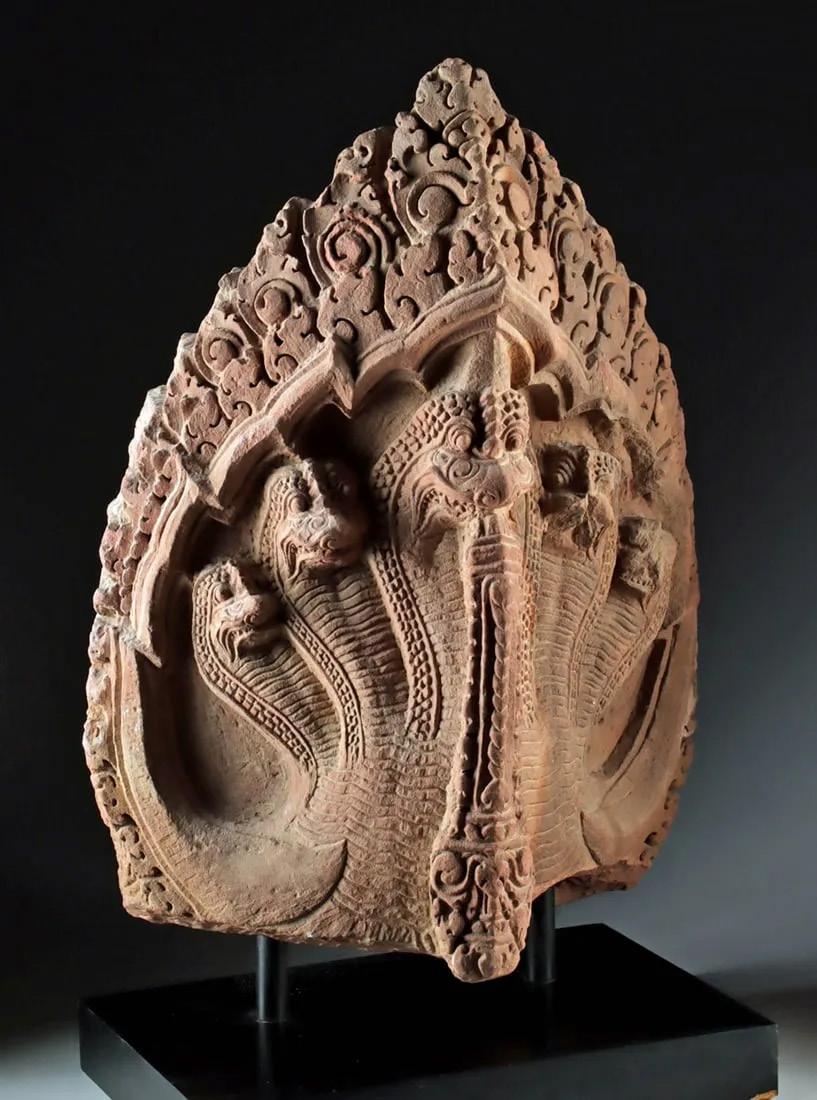

LOT 69
12th C. Khmer Sandstone
Relief of a Devata
Southeast Asia, Cambodia, Khmer Empire, Bayon style, ca. 12th to 13th century CE.
Size: 6” L x 14” W x 31” H (15.2 cm x 35.6 cm x 78.7 cm); 34” H (86.4 cm) on included custom stand.
An impressive stone relief depicting a devata, a minor deity of Buddhism and Hinduism, shown standing with arms at her sides, her hourglass figure lavishly clad in layers of jeweled necklaces, bangles, prayer beads, and an ornate belt supporting a sampot.
LOT 75 Rare Prehistoric Oligocene Dinictis
Saber Cat Skull
North America, Western United States, Oligocene, ca. 33.9 to 23 million years ago.
Size: 6” L x 4.5” W x 4” H (15.2 cm x 11.4 cm x 10.2 cm); 5.25” H (13.3 cm) on included custom stand
A fossilized skull from Dinictis, a prehistoric “false saber-toothed cat” in the Nimravidae family, the lower mandible is completely free from the upper, and mounted to showcase the jaws and teeth!


LOT 76a
Large Moroccan
Spiny Seleopeltis
Trilobite Fossil
North Africa, Morocco, Anti-Atlas Mountains, Ktaoua Formation, Ordovician period, ca. 478.6 to 443.7 million years ago.
Size of matrix: 13.25” L x 13” W (33.7 cm x 33 cm); trilobite: 7” L (17.8 cm)
An unusually large fossil of the spiny Selenopeltis sp. trilobite with fantastic coloration that contrasts with the light gray stone.
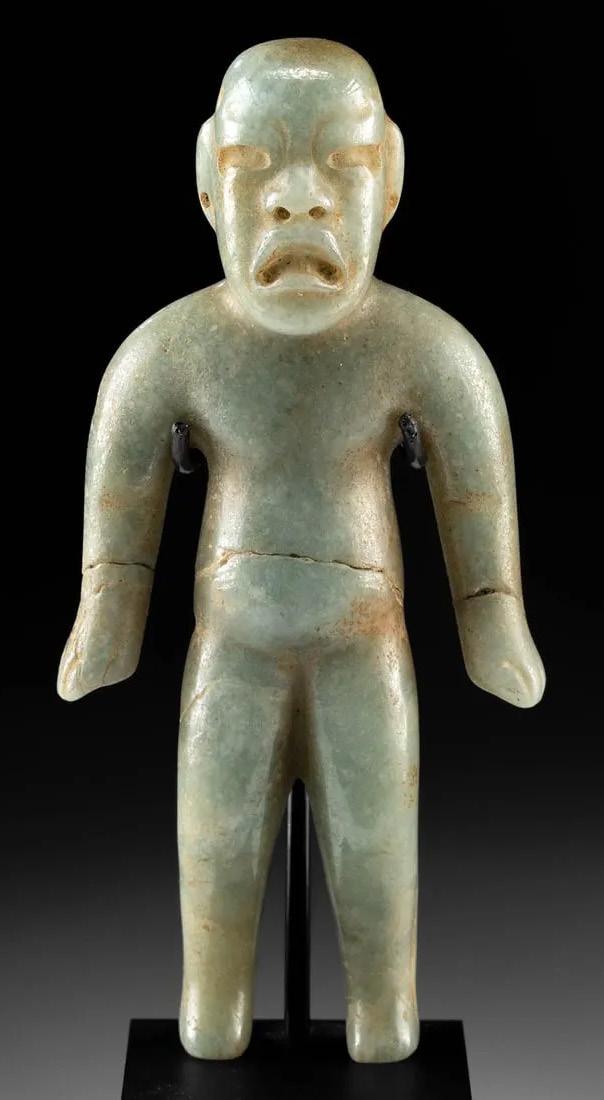
LOT 77
Olmec Jade Were-Jaguar Figure (in Transformation)
Pre-Columbian, Southern Mexico to Guatemala, Olmec, ca. 900 to 500 BCE.
Size: 0.6” L x 2.1” W x 4.7” H (1.5 cm x 5.3 cm x 11.9 cm); 5” H (12.7 cm) on included custom stand.
An exquisite, finely-carved blue-green jadeite were-jaguar figure, standing in a characteristically stiff pose with lengthy arms positioned along his sides and stocky, slightly-bent legs with protruding knees.
LOT 77a
Rare Veracruz Standing Female, Severed Hand on Headband
Pre-Columbian, Gulf Coast of Mexico, Veracruz, ca. 900 to 1200 CE.
Size: 12” H (30.5 cm)
A hand-built pottery female figure of exquisite form, presenting semi-nude with exposed breasts, a knee-length skirt, and arms outstretched like a priestess lecturing over her congregation.
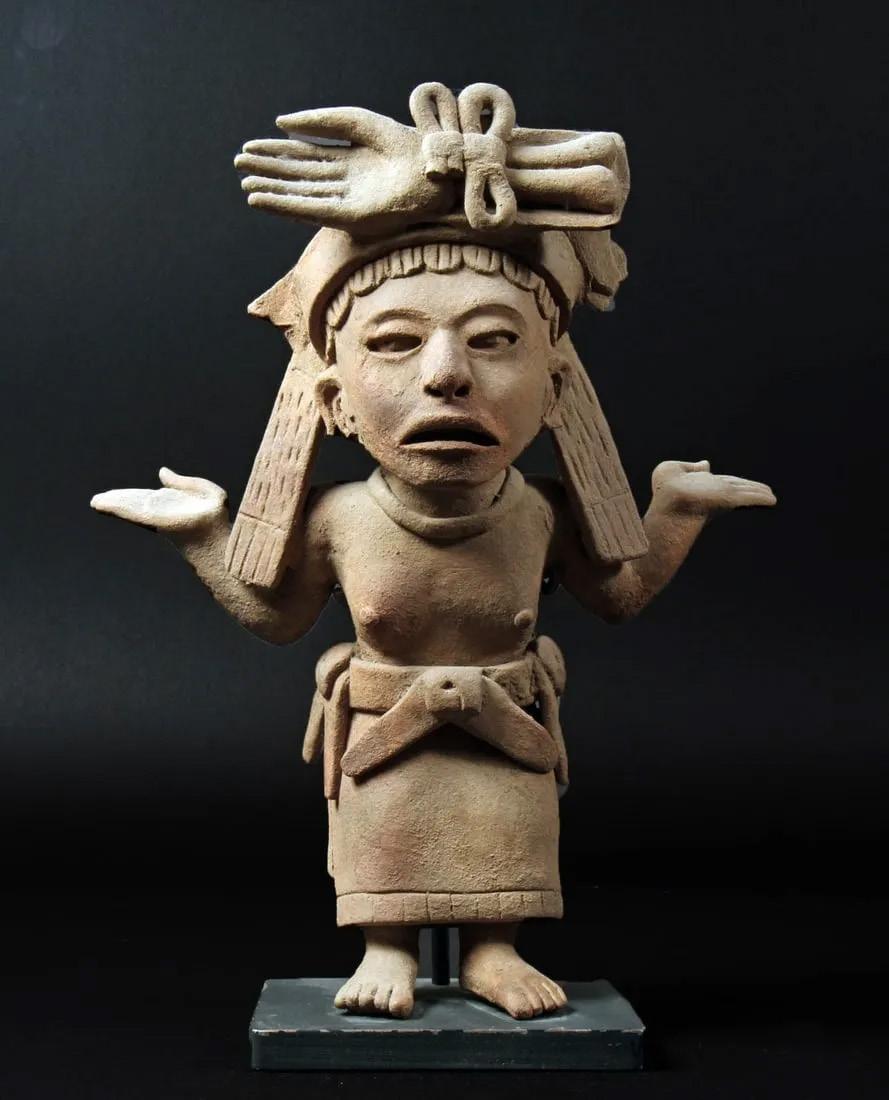
Huge Nayarit Nude Figures - Male + Female (25” High!)

Pre-Columbian, West Mexico, Nayarit, Protoclassic Period, ca. 100 BCE to 250 CE.
Size of largest (male): 10” L x 14” W x 26.875” H (25.4 cm x 35.6 cm x 68.3 cm); (female): 8” L x 15.5” W x 25.5” H (20.3 cm x 39.4 cm x 64.8 cm)
An incredible set of hand-built pottery figures, a man and a woman, each of titanic size when compared to typical figures from this region. Both figures present nude and standing atop huge feet with minimal arches.
LOT 82
Huge Colima Obsidian
Eccentric Flint Stylized Canine
Pre-Columbian, West Mexico, Colima, ca. 100 to 300 CE.
Size: 15.6” L x 6” W (39.6 cm x 15.2 cm); 13” H (33 cm) on included custom stand.
Wow! A remarkably rare and quite breathtaking eccentric flint or blade hand-knapped from a sizable slab of lustrous black obsidian in the form of a stylized dog or canine.
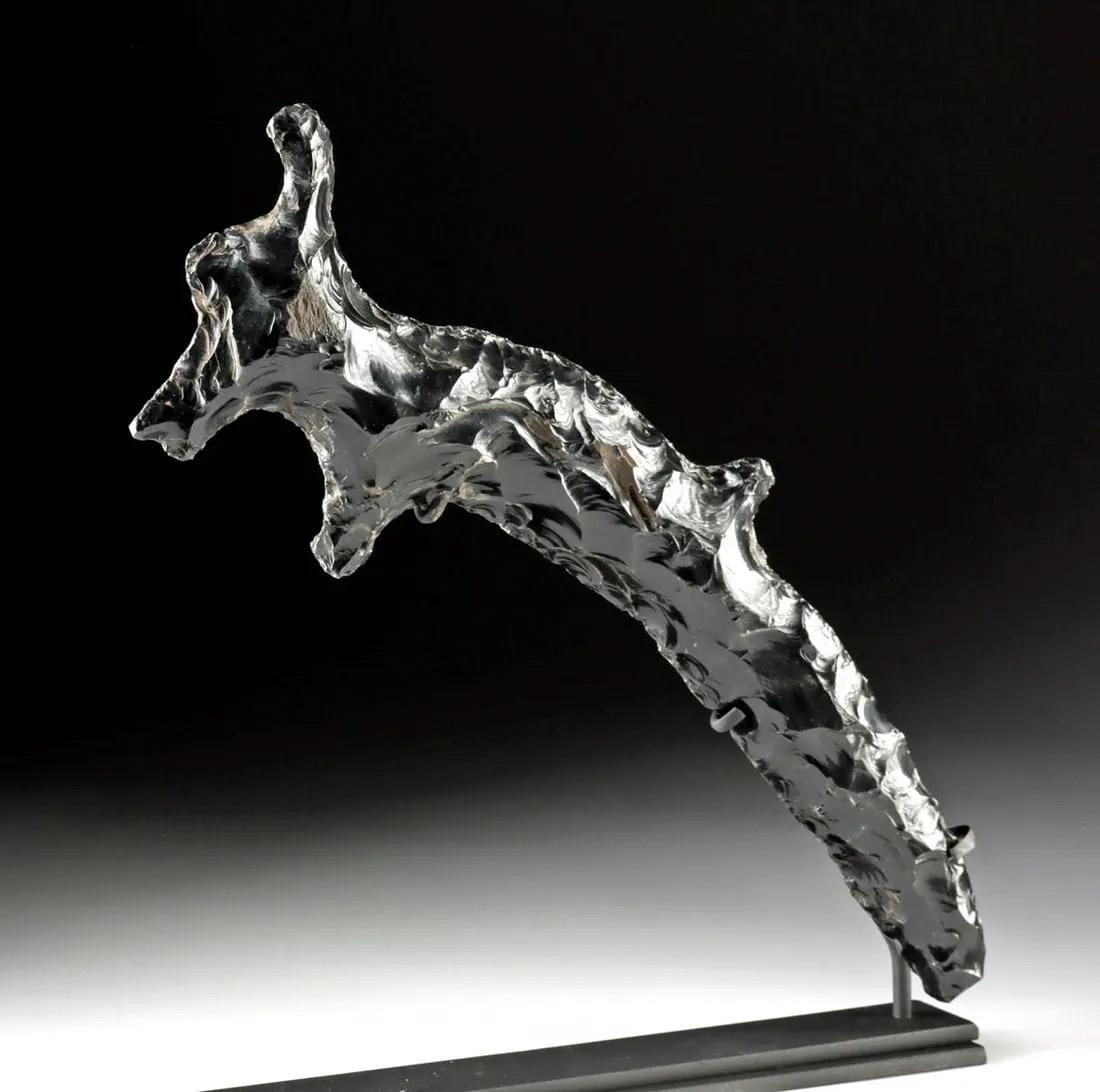
LOT 90a
Maya Late Classic

Polychrome Plate of Chaac (Tlaloc)
Pre-Columbian, Southern Mexico to Guatemala, Maya, Late Classic, ca. 550 to 900 CE.
Size: 10” Diameter x 2” H (25.4 cm x 5.1 cm)
A remarkably unique pottery plate handpainted with red-on-black decoration depicting the head of the rain deity Chaac (Aztec Tlaloc) with large, goggle-shaped eyes. The overall tripartite form represents a thunderhead (cumulus) cloud, and his maw is open with lightning bolts coming off each side fang and 2 torrential downpour streams angling left and right as they hit the ground.
LOT
93
Huge Ancient Costa Rican Jade
Avian Axe God Pendant
Pre-Columbian, Costa Rica, Guanacaste-Nicoya, ca. 250 to 800 CE.
Size: 9.75” L x 1.1” W x 0.7” H (24.8 cm x 2.8 cm x 1.8 cm)
Finely carved and string cut from seafoam and forest green omphacite jade, an axe god celt presenting an avian visage with another bird atop his head - perhaps representing a ruler-shaman undergoing transformation.

LOT 94
Guatemalan Escuintla Tiquisate
Tripod Cylinder Vessel
Pre-Columbian, Guatemala, Escuintla, Tiquisate, ca. 400 to 700 CE.
Size: 4” Diameter x 11” H (10.2 cm x 27.9 cm)
An exquisite pottery tripod jar, mold-impressed with 2 panels of iconographic decoration on the tall, cylindrical body, as well as 3 additional, identical images on the slab-form legs, all highlighted with liberal remains of red pigment.
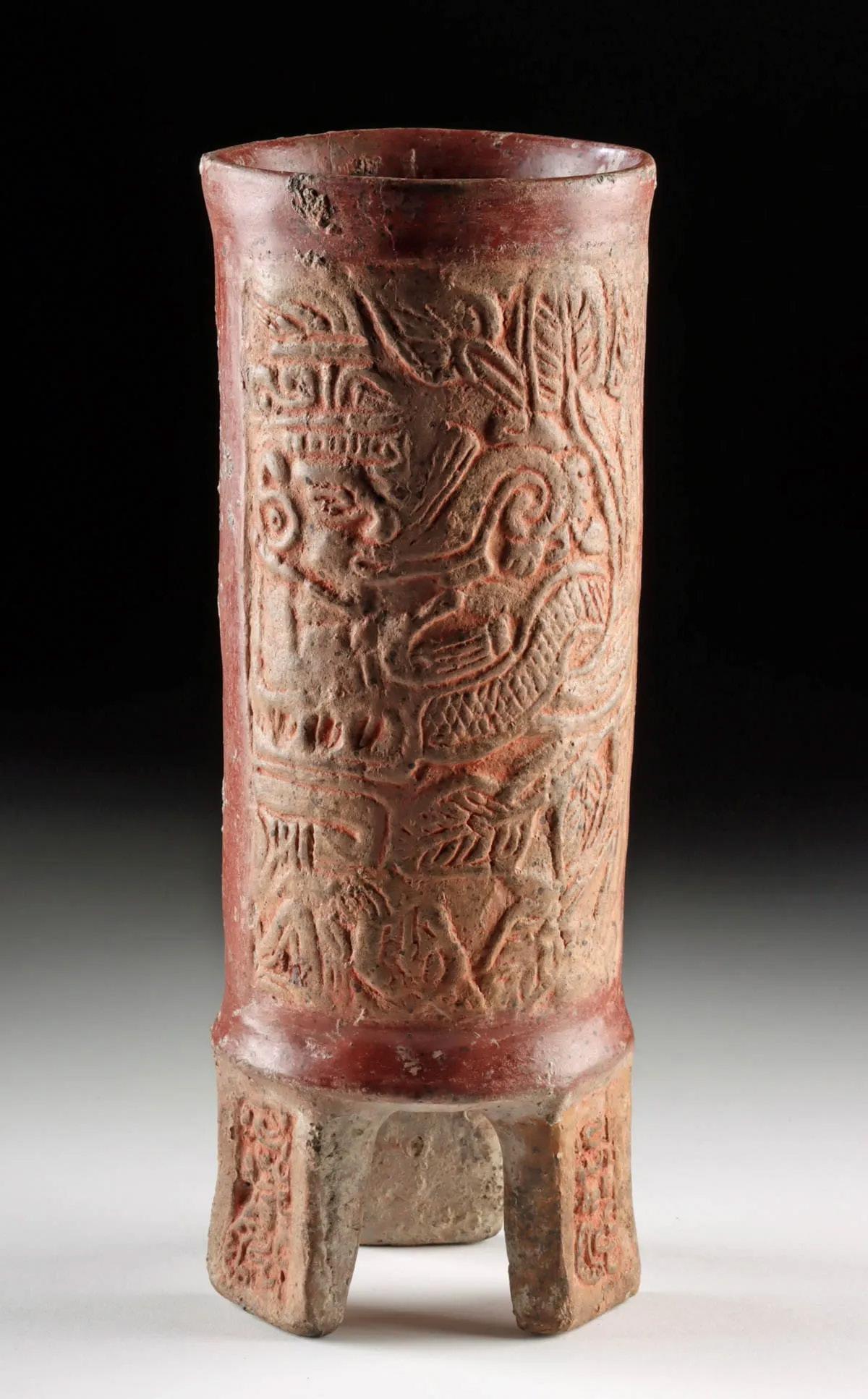
LOT 95
Costa Rican Diquis Gold Pendant, Shaman w/ Animals
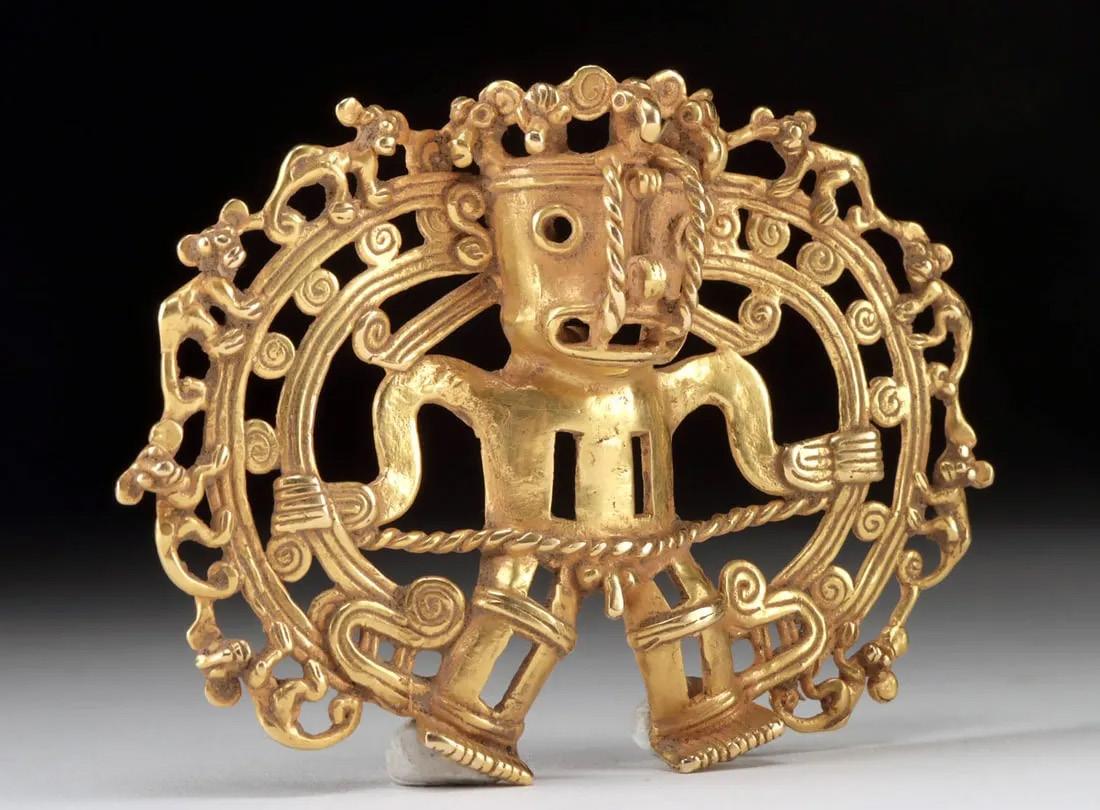
Pre-Columbian, Central America, southern Costa Rica, Diquis, ca. 11th to 16th century CE.
Size: 0.8” L x 3.4” W x 2.6” H (2 cm x 8.6 cm x 6.6 cm); gold quality: 74.5% (equivalent to over 17 karats); weight: 66 grams.
An elaborate openwork gold pendant portraying a nude shaman facing defiantly forward.
LOT 99
Massive Sican-Lambayeque Copper Mask

Pre-Columbian, North Coast of Peru, Sican-Lambayeque culture, ca. 700 to 1000 CE.
Size: 15.9” W x 12” H x 2.5” L (40.4 cm x 30.5 cm x 6.4 cm); 13.875” H (35.2 cm) on included custom stand.
An amazing and sizable mask formed from several sheets of hammered copper arranged to form a stylized human face.
LOT 104
Anasazi Mimbres Black on White Pottery Bowl
Native American, Southwestern United States, New Mexico, Mimbres / Mogollon, ca. 900 to 1100 CE.
Size: 7.4” L x 7” W x 3.5” H (18.8 cm x 17.8 cm x 8.9 cm)
A wonderful pottery bowl presenting a hemispherical form and a deep interior basin hand-painted with black on white decoration.
The figural imagery is comprised of a sunshaped design above a band with crescent finials, and a vertically striated conical motif, all surrounded by a border of crested waves.

LOT 105b
Large Kwakwaka’wakw Huk-huk Raven Mask by Simon Dick

Simon Dick “Tanis” (First Nations Canadian, Kwakwaka’wakw, b. 1951). “Hoh Hok,” polychrome wood, copper, & bark, ca. 2001.
Size with tassels: 52” L x 12.25” W x 30” H (132.1 cm x 31.1 cm x 76.2 cm)
A hand carved cedar wood raven head mask of massive proportions known as a hoh-hok (sometimes spelled huk-huk) with cedar bark tassels and turkey feathers atop the head.
LOT 109
Gorgeous 19th C. Hawaiian Kou Wood Calabash Bowl
North Pacific, Hawaiian Islands, ca. 19th century CE.
Size: 9.5” W x 5” H (24.1 cm x 12.7 cm)
A grandiose and gorgeous calabash bowl, skillfully hand-carved from wood of the kou tree - an inherently beautiful Hawaiian hardwood with a warm glow that shines in the light. Boasting a natural woodgrain surface in rich hues of caramel, chocolate, and espresso, the lovely dish presents a rounded base, a wide hip, and a circular rim that gently curves inward.
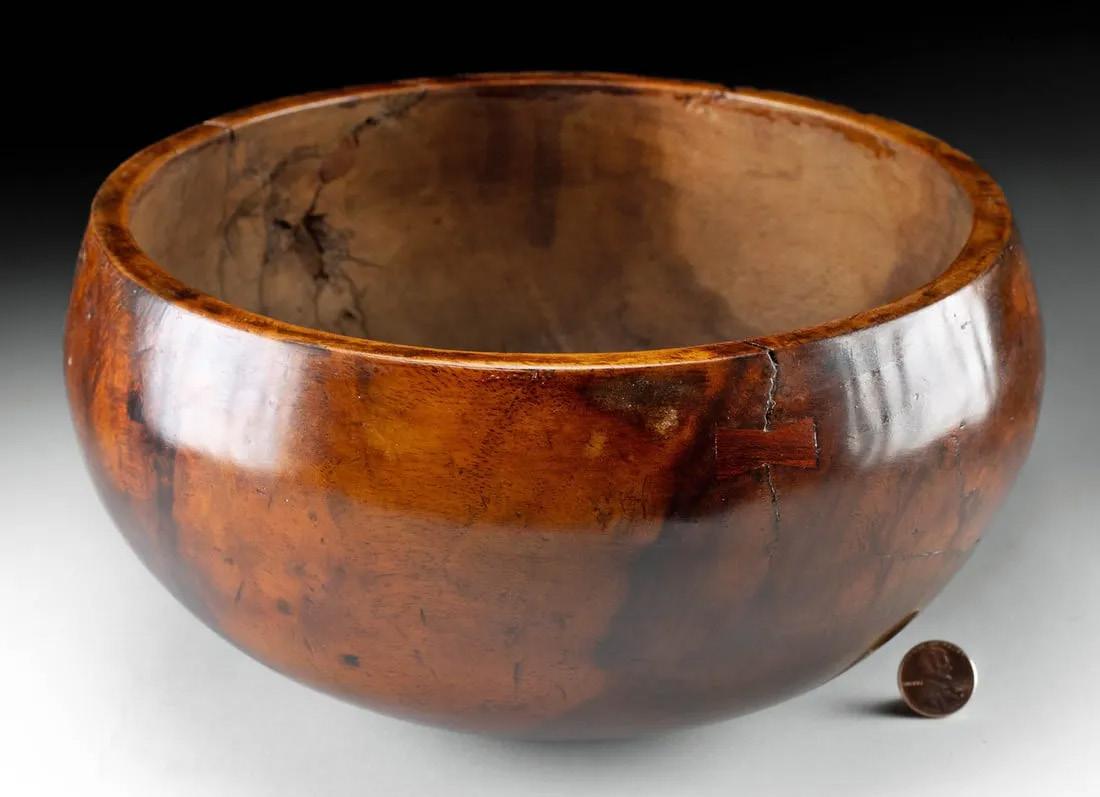
LOT 113a
19th C. Papua New Guinea
Wood Ancestor Figure
Oceania, Papua New Guinea, Sepik River Basin, Iryan Jaya region, ca. 19th century CE.
Size: 3.875” L x 2.6” W x 13.3” H (9.8 cm x 6.6 cm x 33.8 cm); 17” H (43.2 cm) on included custom stand.
A rare and important ancestor figure from Korwar that is impressively carved from a single piece of wood. The stylized human face below features broad nostrils and piercing gaze while the tall central crest is adorned with dozens of drilled holes.

LOT 121
Enormous Early 20th C. German Silver Menorah
Europe, Germany, ca. early 20th century CE.
Size: 14.5” L x 28” W x 34.4” H (36.8 cm x 71.1 cm x 87.4 cm); silver quality: 88 to 90%; weight: 4.63 kg
A dazzling silver menorah featuring a central spherical knob of flame motif surrounded by 8 scroll-like arms, all intricately decorated with relief floral and foliate motifs.

LOT 121b
1940s Art Deco 14 Karat Gold Cigarette Case
North America, United States, Art Deco, ca. 1940s CE.
Size (closed): 3.4” L x 3” W x 0.5” H (8.6 cm x 7.6 cm x 1.3 cm); gold quality: 60% (equivalent to 14 karats); weight: 120.7 grams
A gorgeous 14 karat gold cigarette case of rectangular form, diamond-cut to feature a sunburst design on one side and a series of fine, parallel striations on the other.

LOT 121c
Rare Signed 1793 French Document from Reign of Terror
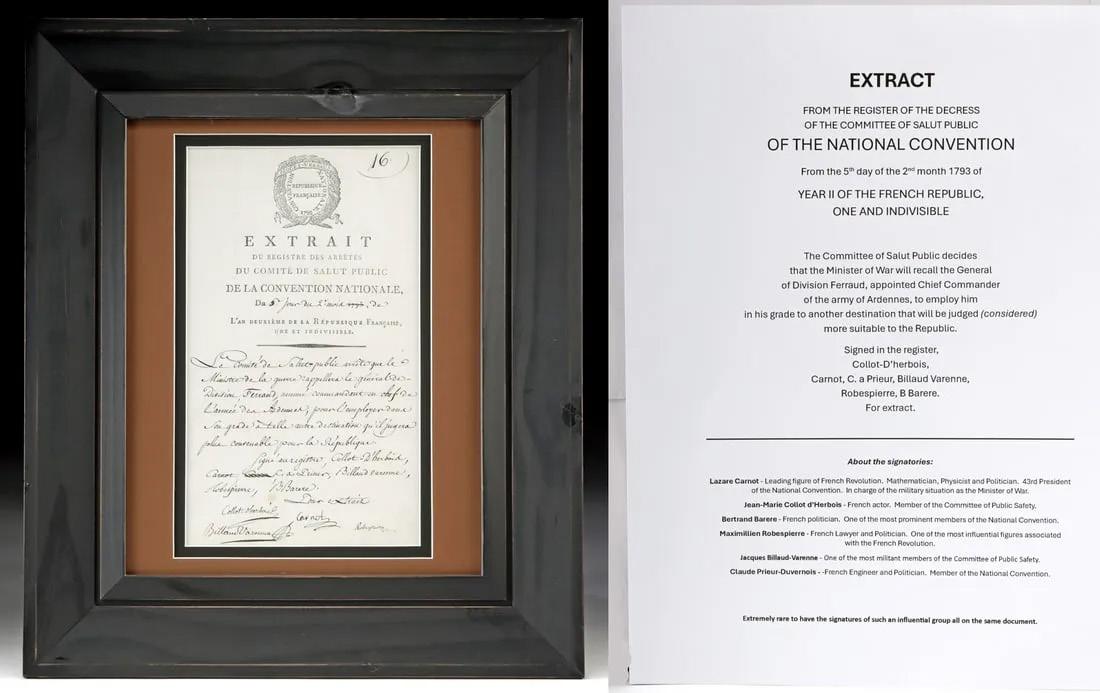
Western Europe, France, First Republic period, Reign of Terror or Mountain Republic, ca. 26th of October 1793. Size of document: 6.8” W x 11.8” H (17.3 cm x 30 cm);
Wow! A rare historical document from the Reign of Terror featuring an impressive collection of signatures from 4 members of the French National Convention: Lazare Carnot, Jean-Marie Collot d’Herbois, Maximilien Robespierre, and Jacques Billaud-Varenne.

View all lots / register to bid on the platform of your choice


Prefer to bid by phone? 720-890-7700
